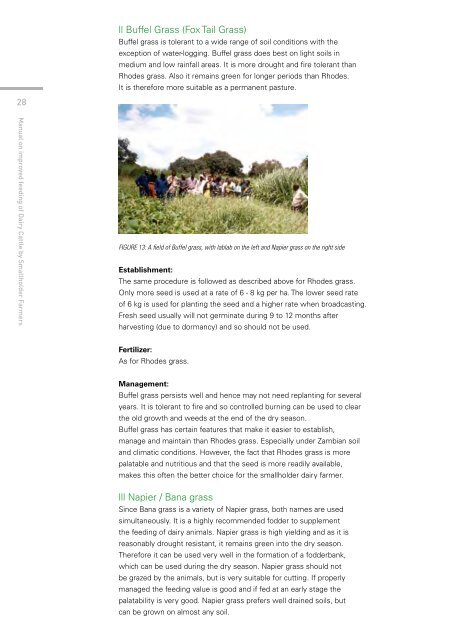MANUAL ON IMPROVED FEEDING OF DAIRY CATTLE BY ... - Gart
MANUAL ON IMPROVED FEEDING OF DAIRY CATTLE BY ... - Gart
MANUAL ON IMPROVED FEEDING OF DAIRY CATTLE BY ... - Gart
Create successful ePaper yourself
Turn your PDF publications into a flip-book with our unique Google optimized e-Paper software.
28<br />
Manual on improved feeding of Dairy Cattle by Smallholder Farmers<br />
ll Buffel Grass (Fox Tail Grass)<br />
Buffel grass is tolerant to a wide range of soil conditions with the<br />
exception of water-logging. Buffel grass does best on light soils in<br />
medium and low rainfall areas. It is more drought and fire tolerant than<br />
Rhodes grass. Also it remains green for longer periods than Rhodes.<br />
It is therefore more suitable as a permanent pasture.<br />
FIGURE 13: A field of Buffel grass, with lablab on the left and Napier grass on the right side<br />
Establishment:<br />
The same procedure is followed as described above for Rhodes grass.<br />
Only more seed is used at a rate of 6 - 8 kg per ha. The lower seed rate<br />
of 6 kg is used for planting the seed and a higher rate when broadcasting.<br />
Fresh seed usually will not germinate during 9 to 12 months after<br />
harvesting (due to dormancy) and so should not be used.<br />
Fertilizer:<br />
As for Rhodes grass.<br />
Management:<br />
Buffel grass persists well and hence may not need replanting for several<br />
years. It is tolerant to fire and so controlled burning can be used to clear<br />
the old growth and weeds at the end of the dry season.<br />
Buffel grass has certain features that make it easier to establish,<br />
manage and maintain than Rhodes grass. Especially under Zambian soil<br />
and climatic conditions. However, the fact that Rhodes grass is more<br />
palatable and nutritious and that the seed is more readily available,<br />
makes this often the better choice for the smallholder dairy farmer.<br />
lll Napier / Bana grass<br />
Since Bana grass is a variety of Napier grass, both names are used<br />
simultaneously. It is a highly recommended fodder to supplement<br />
the feeding of dairy animals. Napier grass is high yielding and as it is<br />
reasonably drought resistant, it remains green into the dry season.<br />
Therefore it can be used very well in the formation of a fodderbank,<br />
which can be used during the dry season. Napier grass should not<br />
be grazed by the animals, but is very suitable for cutting. If properly<br />
managed the feeding value is good and if fed at an early stage the<br />
palatability is very good. Napier grass prefers well drained soils, but<br />
can be grown on almost any soil.


